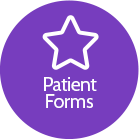6015 100th St. Southwest
Lakewood, WA 98499
253-582-2626
6015 100th St. Southwest | Lakewood, WA 98499 | 253-582-2626
Orthodontics
Orthodontic First Visit
The initial Exam:
The initial exam can be a very helpful way for you to get a clear idea about you or your child's orthodontic needs. The exam will be done at no charge, as a service to you and your dentist. Although a referral is not required to schedule this appointment, we will work closely with your dentist to assure comprehensive care.
At your first visit, photographs of you or your child’s teeth will be taken and viewed on the computer screen. Dr. Chen will examine you or your child's teeth, bite, TMJ and facial soft tissue. This information will be used to give you a preliminary idea of the problems that may be present. Dr. Chen will also present you with possible treatment alternatives, an estimate of the treatment time, an estimate of the cost, and answer any questions you may have. If no treatment is required, Dr. Chen may suggest an observation recall to monitor future growth and development of your child.
If treatment is recommended, we will make arrangements with you to schedule an impression appointment.
The impression/records visit:
The impression/records appointment takes about 60 minutes and usually includes the following:
- Impressions or "molds" of your teeth and bite
- anoramic X-ray
- ephalometric X-ray
Once the records have been taken, Dr. Chen will be able to develop the final diagnosis and treatment plan. This will be presented to you at a subsequent appointment where he will then discuss treatment alternatives, risks/benefits of treatment, and answer any questions you may have.
Braces and appliances can be placed approximately 2 weeks after the impression/records visit.
- What Age Should My Child have an Orthodontic Evaluation?
- Why is It Important to have Orthodontic Treatment at a Young Age?
- What Causes Crooked Teeth?
- How do Teeth Move?
- Will It Hurt?
Orthodontic Frequently Asked Questions
What age should my child have an orthodontic evaluation?
The American Association of Orthodontists (AAO) recommends an orthodontic screening for children by the age of 7 years. At age 7 the teeth and jaws are developed enough so that the dentist or orthodontist can see if there will be any serious bite problems in the future. Most of the time treatment is not necessary at age 7, but it gives the parents and dentist time to watch the development of the patient and decide on the best mode of treatment. When you have time on your side you can plan ahead and prevent the formation of serious problems.
Why is it important to have orthodontic treatment at a young age?
Research has shown that serious orthodontic problems can be more easily corrected when the patient’s skeleton is still growing and flexible. By correcting the skeletal problems at a younger age we can prepare the mouth for the eventual eruption of the permanent teeth. If the permanent teeth have adequate space to erupt they will come in fairly straight. If the teeth erupt fairly straight their tendency to get crooked again after the braces come off is diminished significantly. After the permanent teeth have erupted, usually from age 12-14, complete braces are placed for final alignment and detailing of the bite. Thus the final stage of treatment is quicker and easier on the patient. This phase of treatment usually lasts from 12 - 18 month and is not started until all of the permanent teeth are erupted.
Doing orthodontic treatments in two steps provides excellent results often allowing the doctor to avoid removal of permanent teeth and jaw surgery. The treatment done when some of the baby teeth are still present is called Phase-1. The last part of treatment after all the permanent teeth have erupted is called Phase-2.
What causes crooked teeth?
Crowded teeth, thumb sucking, tongue thrusting, premature loss of baby teeth, a poor breathing airway caused by enlarged adenoids or tonsils can all contribute to poor tooth positioning. And then there are the hereditary factors. Extra teeth, large teeth, missing teeth, wide spacing, small jaws - all can be causes of crowded teeth.
How do teeth move?
Tooth movement is a natural response to light pressure over a period of time. Pressure is applied by using a variety of orthodontic hardware (appliances), the most common being a brace or bracket attached to the teeth and connected by an arch wire. Periodic changing of these arch wires puts pressure on the teeth. At different stages of treatment your child may wear a headgear, elastics, a positioner or a retainer. Most orthodontic appointments are scheduled 4 to 6 weeks apart to give the teeth time to move.
Will it hurt?
When teeth are first moved, discomfort may result. This usually lasts about 24 to 72 hours. Patients report a lessening of pain as the treatment progresses. Pain medicines such as acetaminophen (Tylenol) or ibuprofen (Advil) usually help relieve the pain.
Orthodontic Terms
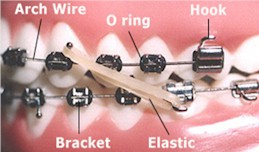
Arch Wire
The part of your braces which actually moves the teeth. The arch wire is attached to the brackets by small elastic donuts or ligature wires. Arch Wires are changed throughout the treatment. Each change brings you closer to the ideal tooth position.
Brackets
Brackets are the “Braces” or small attachments that are bonded directly to the tooth surface. The brackets are the part of your braces to which the dentist or assistant attaches the arch wire.
Occasionally, a bracket may come loose and become an irritation to your mouth. You can remove the loose bracket and save it in an envelope to bring to the office. Call the office as soon as possible and make an appointment to re-glue the bracket.
Elastics (Rubber Bands)
At some time during treatment, it will be necessary to wear elastics to coordinate the upper and lower teeth and perfect the bite. Once teeth begin to move in response to elastics, they move rapidly and comfortably. If elastics (rubber bands) are worn intermittently, they will continually "shock" the teeth and cause more soreness. When elastics are worn one day and left off the next, treatment slows to a standstill or stops. Sore teeth between appointments usually indicate improper wear of headgear or elastics or inadequate hygiene. Wear your elastics correctly, attaching them as you were told. Wear elastics all the time, unless otherwise directed. Take your elastics off while brushing. Change elastics as directed, usually once or twice a day.
Headgear
Often called a “night brace”. The headgear is used to correct a protrusion of the upper or lower jaw. It works by inhibiting the upper jaw from growing forward, or the downward growth of the upper jaw or even by encouraging teeth to move forward, if that is the case.
Malocclusion
Poor positioning of the teeth.
Types of Malocclusion
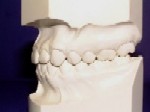 Class I A Malocclusion where the bite is OK (the top teeth line up with the bottom teeth) but the teeth are crooked, crowded or turned. |
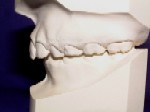 Class II A Malocclusion where the upper teeth stick out past the lower teeth. |
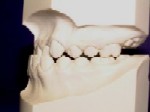 Class III A Malocclusion where the lower teeth stick out past the upper teeth. This is also called an "underbite". |
Occlusion
The alignment and spacing of your upper jaw and lower teeth when you bite down.
Types of Occlusion:
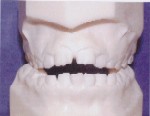 Openbite Anterior opening between upper and lower teeth. |
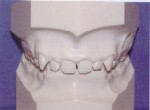 Overbite Vertical overlapping of the upper teeth over the lower. |
 Overjet Horizontal projection of the upper teeth beyond the lower. |
 Crossbite When top teeth bite inside the lower teeth. It can occur with the front teeth or back teeth. |
O Rings
O rings, also called A-lastics, are little rings used to attach the arch wire to the brackets. These rings come in standard gray or clear, but also come in a wide variety of colors to make braces more fun. A-lastics are changed at every appointment to maintain good attachment of the arch wire to the bracket, enabling our patients to enjoy many different color schemes throughout treatment.
Separator
A plastic or rubber donut piece which the dentist uses to create space between your teeth for bands.
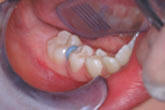
Fixed and Removable Appliances
 Band & Loop (B & L)
Band & Loop (B & L)
A Band & Loop is routinely used to hold space for a missing primary (baby) posterior (back) tooth until the permanent tooth can grown in.
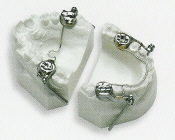 Herbst
Herbst
An appliance designed to encourage the lower jaw to grow forward and “catch up” to upper jaw growth.
Lower Lingual Arch (LLA)
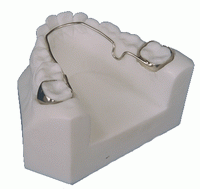 A lower lingual arch is a space maintainer for the lower teeth. It maintains the molars where they are, it does not move them. This is fabricated by placing bands on the molars and connecting them to a wire that fits up against the inside of the lower teeth. It keeps the molars from migrating forward and prevents them from blocking off the space of teeth that develop later. This is used when you have the early loss of baby teeth or when you have lower teeth that are slightly crowded in a growing child and you do not want to remove any permanent teeth to correct the crowding.
A lower lingual arch is a space maintainer for the lower teeth. It maintains the molars where they are, it does not move them. This is fabricated by placing bands on the molars and connecting them to a wire that fits up against the inside of the lower teeth. It keeps the molars from migrating forward and prevents them from blocking off the space of teeth that develop later. This is used when you have the early loss of baby teeth or when you have lower teeth that are slightly crowded in a growing child and you do not want to remove any permanent teeth to correct the crowding.
Palatal Expander
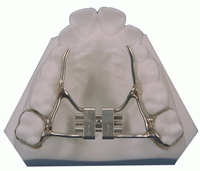 An appliance which is placed in the roof of the mouth to widen the upper dental arch. The maxilla, or upper dental arch, is joined in the center by a joint, which allows it to be painlessly separated and spread. Temporarily you may see a space develop between the upper two front teeth. This will slowly go away in a few days. Once this has occurred, the two halves knit back together and new bone fills in the space.
An appliance which is placed in the roof of the mouth to widen the upper dental arch. The maxilla, or upper dental arch, is joined in the center by a joint, which allows it to be painlessly separated and spread. Temporarily you may see a space develop between the upper two front teeth. This will slowly go away in a few days. Once this has occurred, the two halves knit back together and new bone fills in the space.
Quad Helix
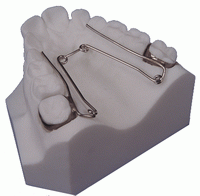 This appliance provides continual, gradual pressure in as many as four directions, to move molars, expand or contract arches or assist in eliminating finger or thumb habits.
This appliance provides continual, gradual pressure in as many as four directions, to move molars, expand or contract arches or assist in eliminating finger or thumb habits.
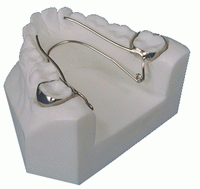
Bi Helix
An appliance used to expand the lower arch without interfering with tongue posture or movement.
Hawley
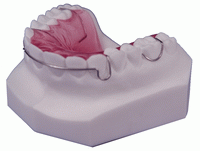 A universally used retainer with many applications; to move teeth, close spaces, maintain alignment during or after treatment.
A universally used retainer with many applications; to move teeth, close spaces, maintain alignment during or after treatment.
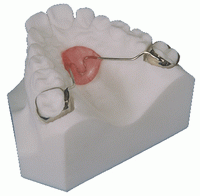
Nance
This appliance maintains the position of the maxillary molars without using any other teeth. The plastic button on the palate provides stability.
Retainers
At the completion of the active phase of orthodontic treatment, braces are removed and removable appliances called retainers are placed. To retain means to hold. Teeth must be retained or held in their new positions while the tissues, meaning the bone, elastic membranes around the roots, the gums, tongue and lips have adapted themselves to the new tooth positions. Teeth can move if they are not retained. It is extremely important to wear your retainers as directed!
Orthodontic Care
Braces Care
You will be shown the proper care of your braces when your orthodontic treatment begins. Proper cleansing of your mouth is necessary every time you eat. Teeth with braces are harder to clean, and trap food very easily. If food is left lodged on the brackets and wires, it can cause unsightly etching of the enamel on your teeth. Your most important job is to keep your mouth clean. If food is allowed to collect, the symptoms of gum disease will show in your mouth. The gums will swell and bleed and the pressure from the disease will slow down tooth movement.
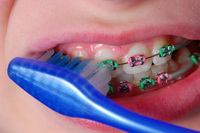 BRUSHING: You should brush your teeth 4-5 times per day.
BRUSHING: You should brush your teeth 4-5 times per day.
- Brush back and forth across……between the wires and gums on the upper and lower to loosen any food particles.
- Next, brush correctly as if you had no brackets or appliances on.
- Start on the outside of the uppers with the bristles at a 45 degree angle toward the gum and scrub with a circular motion two or three teeth at a time using ten strokes, then move on.
- Next, do the same on the inner surface of the upper teeth.
- Then, go to the lower teeth and repeat steps 2, 3 and 4.
Look in a mirror to see if you have missed any places. Your teeth, brackets and wires should be free of any food particles and plaque.
Note: If your gums bleed when brushing, do not avoid brushing, but rather continue stimulating the area with the bristles. Be sure to angle your toothbrush so that the area under your gum line is cleaned. After 3 or 4 days of proper brushing, the bleeding should stop and your gums should be healthy again.
FLOSSING: Use a special floss threader to floss with your braces on. Be sure to floss at least once per day.
FLUORIDE RINSE OR GEL: May be recommended for preventive measures.
Appliance Care
Clean the retainer by brushing with toothpaste. If you are wearing a lower fixed retainer be extra careful to brush the wire and the inside of the lower teeth. Always bring your retainer to each appointment. Avoid flipping the retainer with your tongue, this can cause damage to your teeth. Place the retainer in the plastic case when it is re-moved from your mouth. Never wrap the retainer in a paper napkin or tissue, someone may throw it away. Don't put it in your pocket or you may break or lose it. Excessive heat will warp and ruin the retainer.
Elastics Care
If elastics (rubber bands) are worn intermittently, they will continually "shock" the teeth and cause more soreness. Sore teeth between appointments usually indicate improper wear of headgear or elastics or inadequate hygiene. Wear your elastics correctly, attaching them as you were told. Wear elastics all the time, unless otherwise directed. Take your elastics off while brushing. Change elastics as directed, usually once or twice a day.
Proper Diet
Avoid Sticky Foods such as: Caramels |
Avoid Hard or Tough Foods Such as: Pizza Crust |
Cut the following foods into small pieces and chew with the back teeth: Apples |
Orthodontic Emergencies or Problems
Please feel free to contact the office if you are experiencing any discomfort or if you have any questions. Below are a few simple steps that might help if you are unable to contact us or if you need a “quick fix”.
Loose Bracket
Occasionally, a glued bracket may come loose. You can remove the loose bracket and save it in an envelope to bring to the office or leave it where it is, if it is not causing any irritation. Call the office as soon as possible in order for us to allow time to re-glue the bracket.
Poking Wire
If a wire is poking your gums or cheek there are several things you can try until you can get to the office for an appointment. First try a ball of wax on the wire that is causing the irritation. You may also try using a nail clipper or cuticle cutter to cut the extra piece of wire that is sticking out. Sometimes, a poking wire can be safely turned down so that it no longer causes discomfort. To do this you may use a pencil eraser, or some other smooth object, and tuck the offending wire back out of the way.
Wire Out of Back Brace
Please be careful to avoid hard or sticky foods that may bend the wire or cause it to come out of the back brace. If this does happen, you may use needle nose pliers or tweezers to put the wire back into the hole in the back brace. If you are unable to do this, you may clip the wire to ease the discomfort. Please call the office as soon as possible to schedule an appointment to replace the wire.
Poking Elastic (Rubber Band) Hook
Some brackets have small hooks on them for elastic wear. These hooks can occasionally become irritating to the lips or cheeks. If this happens, you may either use a pencil eraser to carefully push the hook in, or you can place a ball of wax on the hook to make the area feel smooth.
Sore Teeth
You may be experiencing some discomfort after beginning treatment or at the change of wires or adjusting of appliances. This is normal and should diminish within 24-72 hours. A few suggestions to help with the discomfort:
- Rinse with warm water, eat a soft diet, take acetaminophen (Tylenol) or ibuprofen (Advil) as directed on the bottle.
- Chewing on the sore teeth may be sorer in the short term but feel better faster.
- If pain persists more than a few days, call our office.


